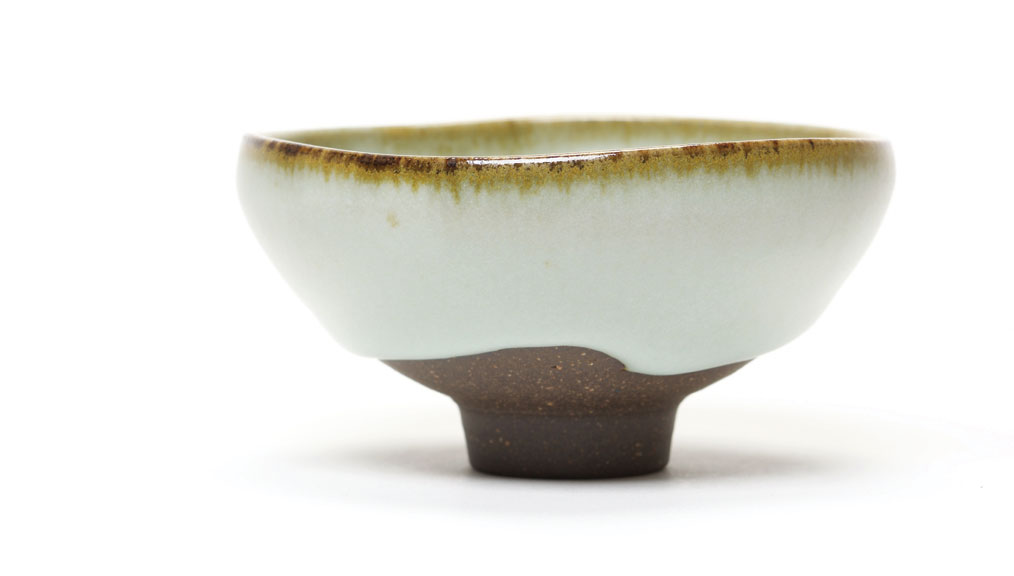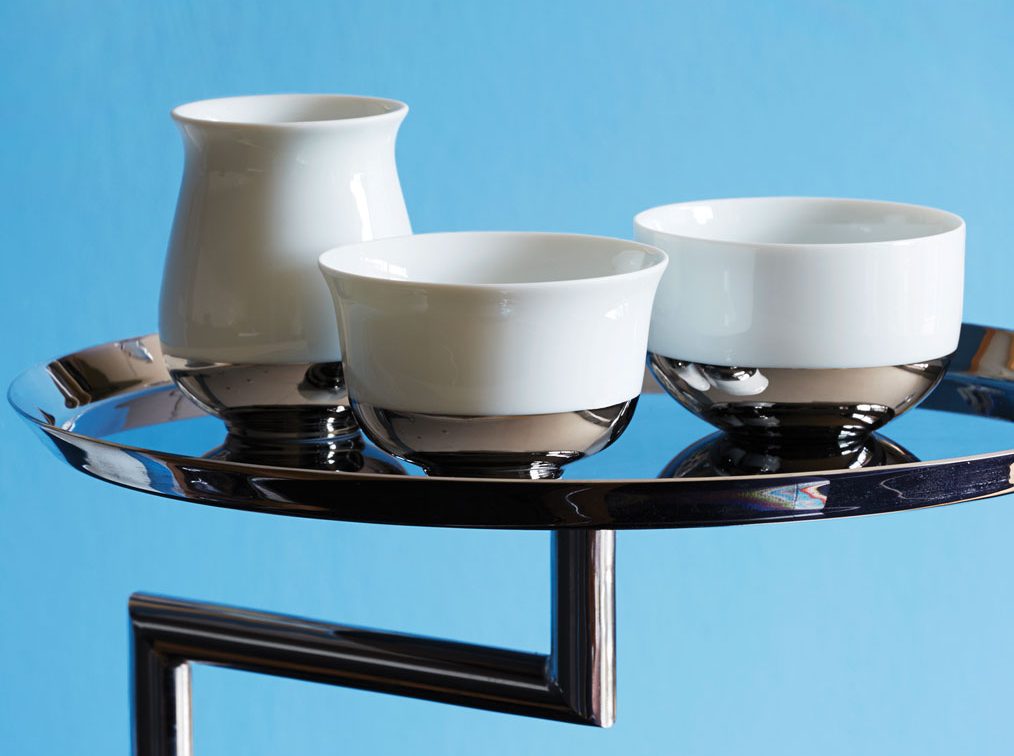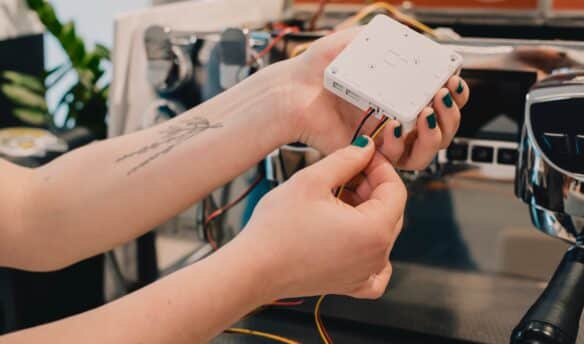The choice of teacups was a key decision for Andrew Perryman as he prepared to open his London tea shop, Tea & Glory, in March 2017.
Would he go Eastern traditional and choose Japanese-style clay gaiwan bowls, or Chinese blue and white ceramic? Or should he opt for British traditional, with English fine bone china? There were considerations beyond material, too. Handle or no handle; saucer or no saucer?
“Cups are fundamental to a good customer experience,” Perryman says, who left his job in finance to launch his tea company.
Tea & Glory sells single-origin, artisanal teas, and Perryman, a certified tea sommelier, has visited the farms of the teas he sells. He looked to his company ethos to inform his choice of cups.
“You think about what type of company you want to be, what kind of values you have,” he says. “We wanted to distinguish ourselves through our cups and tell our story.”
He selected a double-walled glass mug with a handle and an elegant, curved lip. Similar to glazed ceramic, glass wouldn’t interfere with the flavor of the tea (like unglazed stoneware would), and it would showcase the myriad colors of the beverage. The handle would make the cup more accessible for England’s traditional tea drinkers, and the curved lip would add a special element to enhance the experience. Plus, the cups would withstand a busy café environment and hold up well in the dishwasher.
“It took us a long time to find a design,” Perryman says, explaining that he and his team sought a sophisticated cup. “People can see that a little more thought went into it than just mass-produced containers.”
Tea shops that choose glass cups often do so for the same reason as Perryman: a desire to put the shades of tea—the ambers, greens, reds, and blacks—on display. Others choose homemade pottery, delicate porcelain, mismatched china, or mugs with the company logo.
Kevin Gascoyne co-owns Camellia Sinensis, a teahouse, boutique, and tea school in Montreal, Québec. The vessels used in his tea shop are chosen depending on the tea the customer has ordered. “Teaware enhances the moment of sitting down to drink tea, so the nicest teaware you can offer is always going to improve that moment,” he says.
With each order, staff at Camellia Sinensis consider how the material of the cup might react with the water and flavor, the shape and size of the cup—which affect the sensory experience of how the liquid hits the mouth and tongue—and what role aroma will play in the tasting experience. Finally, the aesthetic is taken into consideration, which heightens the customer experience—“connecting the sipper to a tea-drinking culture thousands of years old,” Gascoyne says.
“Most of the bowls we’re using will be put together in a specific style to enhance the flavor profile we’re presenting to customers,” he adds, noting there’s a lot of wisdom behind the more traditional designs such as ergonomics and subtle textures to please the hand and lips.
Taking tea at Camellia Sinensis, a client could sip matcha from a bowl valued at 150 Canadian dollars (about 113 US dollars), or cradle a ninety-dollar cup from China. Gascoyne acknowledges there’s some loss through breakage, but says “most people leave and they’ve never experienced anything like it. Many remain loyal by becoming internet clients, and we have clients coming from all over the world.”
Cups & Culture
For shop owners committed to offering an authentic cultural experience, choosing teaware reflective of a particular tea culture is a favored option.
Turkish café Simit and Chai in Toronto, Ontario, uses the vessel popular in the Turkish tea tradition, a tulip-shaped glass resting on a small, porcelain saucer with colorful decorations. Dobrá Tea’s eight US locations select vessels depending on the culture and traditions of the tea they’re serving, such as gaiwans for Chinese tea and clay pots for Indian tea.
Russian Tea Time in Chicago serves its house Russian tea—their top seller—in narrow, cut crystal glasses that fit snuggly into a podstakannik, a metal tea glass holder with a handle, decorated with patterned etchings and popularized in the late nineteenth century, when tea became commonplace in Russia. With hot tea inside, the cut crystal glass is too hot to hold; the podstakannik creates a barrier, one that can be made into a work of art depending on the etchings and materials used (silver is common).
While using traditional vessels enhances the moment of taking tea, the decision to focus the tea shop on a particular tea culture can be limiting, excluding potential customers who are unfamiliar with that country’s tea customs. Follow Perryman’s advice and look to your company ethos and brand to help guide your decision.
Form & Function
Research and experimentation show that similar to wine, a teacup’s style and shape influence the flavor and sensory experience.
Timothy d’Offay of London’s Postcard Teas collaborated with English ceramics designer Peter Ting to produce a series of three luxury white porcelain tea tasting cups, designed to optimize the flavors of teas.
The Fragrance Cup is a tulip-shaped vessel ideal for an aromatic tea; the shape retains heat and channels the fragrant vapors to the nose, allowing the olfactory to complement the taste. The Balance Cup has a wide top, with steep vertical sides and a curved bottom. This shape delivers more liquid into the mouth, allowing for a full-bodied experience, which is desirable for black teas. The Texture Cup works best for green teas because of its large surface area. The curved lip enhances the tactile experience and allows for more control of the placement of the liquid as it enters the mouth.
In 2012, the cup series, named 1660 London, won Best New Product at the World Tea Expo in Las Vegas and has been added to the permanent collection of London’s Victoria and Albert Museum. In North America, the set is sold exclusively through Gascoyne’s Camellia Sinensis.
The Traveling Teacup
While cup design is a primary consideration of in-house teaware, what role does it play in disposable cups? Since the Tang dynasty in 618 to 907 CE, vessels have been crafted specially for drinking tea, influenced over time by culture, industry, fashions of the day, and technology. In the twentieth century, to-go culture impelled the rise of the disposable cup.
Many tea shop owners submit that the very idea of taking tea to go is contradictory to the slow food tradition of the drink, noting that the psychological benefits of tea require slowing down, calming the mind, and drinking with intention.
The most common complaint of tea to go is permeation from materials of the disposable cups into the tea, contaminating flavor. The preferred option is to encourage customers to use travel mugs, and many tea shops offer a per-cup discount to promote the option.
Jane Pettigrew is the education director of the UK Tea Academy in London and has written books and articles on teaware and culture. Though she prefers taking tea in-house, she recognizes the permanence of tea to go and says branding cups is “quite important. It’s like bags and other packaging that people carry around. Why lose an opportunity to advertise your brand?”
For Andrew Perryman, extending Tea and Glory’s newly designed corporate identity to his to-go cups was a no-brainer. His double-walled cups have a brown background with orange tea leaves and a pattern of dots, a graphic representation of the terroir of tea.
Minnesota’s TeaSource, an award-winning tea importer and shop with three locations, offers its fine teas to go in paper cups branded with the simple but elegant company logo. When owner Bill Waddington opened TeaSource in the nineties in a spare bedroom, the cost of purchasing branded cups wasn’t worth the expense, he recalls, noting that most printers at the time required an order of quantities far beyond what his shops would use. Eventually, he added the logo with mixed success, he says, because he didn’t brand the sleeve, which covered the logo.
Learning from each iteration of his cups, he regularly revisits how he can improve his vessels, to stay and to go. “We’re always trying to do a better job,” Waddington says.
Joshua Zad of Alfred Tea Room in Los Angeles, California, says design—from the blush paint on the walls to the pattern on the disposable cups—is “a major part of the appeal of Alfred.”
Zad says people love collecting Alfred’s to-go cups, which feature a rose-pink background, hand-drawn white and black floral designs, and a Victorian-inspired frame encasing the word “tea” with antlers extending from the top of the A.
The tea shop, which opened in May 2016, is a spin-off of Alfred Coffee, a popular chain in LA with an established brand. The coffee shops and the tea room share design elements like the font and antlers, but the blush pink is the tea shop’s very own.
To Zad, presenting a brand that customers connect with emotionally forms part of his business strategy. The proof is in the social pudding: you only need to check Instagram, Twitter, or Facebook to witness the global reach of fans endorsing Alfred’s aesthetic.
Zad considers the cost of branding cups to be minimal compared to the value gained in customer loyalty. “You could post a photo of your drink everyday on social media and your friends and followers will not get fatigued by it,” he says. “If you can deliver that beverage to customers in unique and cute packaging, you are making it even easier.”
Tea All the Time
Tea shops will not always be able to offer the best vessel for tea; café environment and budget considerations necessitate a certain amount of compromise, in both to-stay and to-go cups.
To find the right option for your shop, consider where you are willing to make compromises. Is it on the quality of the tea leaves in favor of vessels? The cost of replacing cups when they break? The aesthetic and sensory experience? Authenticity to a particular tea culture and tradition?
Ultimately, look to your brand to guide your choice.
“Choosing your teaware is part of the whole process of planning your tea room,” Pettigrew says. “For me, it’s one of the most important elements. . . the choice of teaware goes hand in hand with your approach to creating a wonderful space.”
For Tea and Glory, the company philosophy led Perryman to select glass cups that showcase the myriad colors of the teas he serves. Dobrá Tea opted for culturally authentic vessels to align with its mission.
In the case of Camellia Sinensis, luxury teawares are in line with the brand. But, Gascoyne says, a preference for exquisite vessels does not mean he is rigid about how people should or should not consume tea.
“We’re very encouraging of people to drink tea at any time. If there are occasions where there is a certain amount of compromise to be made for the possibility of serving tea, we don’t mind. . . as long as we feel we’ve done the best for that situation,” he says. “Everyone should be drinking tea all the time, that’s basically our idea.”
The Hidden Value of Paper Cups
Do customers really notice—or care—what’s on their paper cups? The controversy and excitement around Starbucks’s red holiday cups suggests they do, as does 7-Eleven’s “7-Election” campaigns, which offer customers a choice of cups branded with their preferred electoral candidate, an unofficial poll that has been surprisingly accurate in predicting US election outcomes.
Believing in the potential of cups to spread messages, Sidharth Singh of Mumbai, India, launched CupShup, a business that sells advertising on cups to corporate clients, then delivers the cups free of charge to more than 2,500 tea vendors.
“Tea is special to Indians and a significant amount of discussion transpires over a cup of tea every day,” he says.
The content of the cup ad functions as a discussion prompt, influencing the conversation and therefore making “a deeper impression in the customer’s mind,” especially given the exposure time is five to seven minutes, which is more than radio, TV, or print ads.
The company conducts regular surveys to gauge the effectiveness of cup advertising (brand recall is more than 90 percent, Singh says) and tracks success with coupon codes and other promotions. CupShup’s clients—including Coca-Cola, Google, and Uber—have reported business gains tied directly to their advertising through CupShup.
—Jessica Natale Woollard is a freelance writer based in Victoria, British Columbia.























